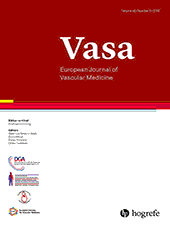N-butyl cyanoacrylate in the treatment of venous insufficiency - the effect of embolisation with ablative polymerisation
Abstract
Abstract. Background: The primary objective of this multicentre prospective observational study was to evaluate the early results of a new non-thermal embolisation method using N-butyl cyanoacrylate in venous insufficiency. Patients and methods: A total of 181 patients with a varicose vein diagnosis were treated with the VariClose: Vein Sealing Systems at four different centres. The protocol included physical and colour Doppler ultrasonography examination, venous clinical severity score and quality of life assessment before and after the procedure on days 1 and 7 and at months 1, 3 and 6. Clinical recovery was evaluated by comparing the venous clinical severity score and the quality of life assessment before and after the procedure. Results: In total, 215 embolisation procedures were successfully completed on 181 patients (110 female) with a mean age of 37.6 ± 13.2 years (range 18 - 72 years). The 215 procedures consisted of 25 bilateral applications on 206 great saphenous veins and 9 small saphenous veins. The average pre-interventional diameter of great saphenous veins was 6.5 ± 1.4 mm (4.3 - 14 mm), and the mean diameter of small saphenous veins was 5.2 ± 1.3 mm (3.8 - 8.6 mm). The average length of the sealed vein segments was 31.6 ± 6.1 cm (23 - 70 cm), and the average N-butyl cyanoacrylate usage for the patient was 0.9 ml (0.7 - 2.1 ml). The procedural occlusion rate was 100 %. Post-operative pain was observed in 11 patients (6.1 %), and thrombophlebitis was observed in 1 patient (0.5 %). No total recanalisation was observed. Five (2.7 %) partial recanalisations were observed at the 6 month follow-up. The 6 month total occlusion rate was 97.2 %. Conclusions: This new tumescent-free non-thermal embolisation method can be applied safely with high success rates.



